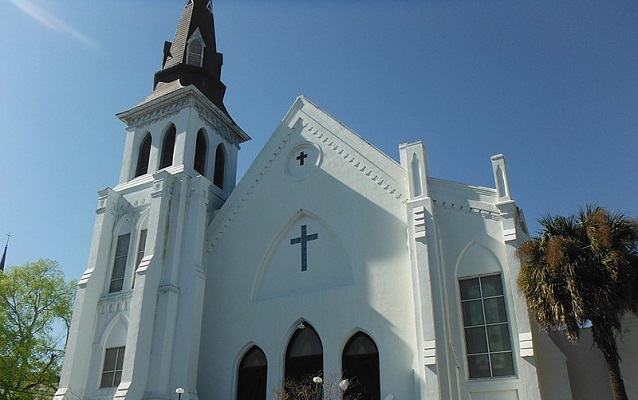Last updated: June 28, 2021
Place
South Carolina: Mother Emanuel AME Church

Photo taken by EvanGuthrie, CC BY-SA 4.0, https://commons.wikimedia.org/w/index.php?curid=62642
The Mother Emanuel African Methodist Episcopal (AME) Church is a Gothic Revival style church built in 1891. Retaining its original altar, communion rail, pews, and light fixtures the church is one of only a few unaltered religious interiors in Charleston, especially from the Victorian period. The brick Gothic church with its tall steeple replaced an earlier 1872 church badly damaged by the 1886 earthquake. Today Emanuel is the oldest AME church in the South, and houses the oldest Black congregation south of Baltimore, Maryland.
The history of this congregation reflects the development of religious institutions for African Americans in Charleston. Its roots stem from a religious group of both enslaved and free African Americans organized in 1791. In 1816, Black members of Charleston's Methodist Episcopal church withdrew over disputed burial ground, and under the leadership of Morris Brown, formed a separate congregation. The church's 1400 members soon thereafter established themselves as an African Methodist Episcopal church, a denomination formally established in 1816 in Philadelphia, Pennsylvania. Two years later, Brown and other ministers of the church were jailed for violating state and local laws which prohibited religious gatherings of enslaved people and free blacks independent of white supervision.
In 1822 the church was investigated for its involvement with a planned uprising of enslaved Africans led by Denmark Vesey, one of the church's founders. Vesey was raised in slavery in the Virgin Islands among newly imported Africans. He was the personal servant of slave trader Captain Joseph Vesey, who settled in Charleston in 1783. Denmark remained with him until in 1799, when he was able to purchase his freedom with a winning lottery ticket worth $1500.Vesey became a successful carpenter, especially among Charleston's majority Black population. In 1821, he formulated a plan to win freedom for the enslaved people of the city. The authorities were informed of the plot before it could take place. Three hundred and thirteen alleged participants were arrested, and 35 (including Vesey) were executed. The plot created mass hysteria throughout the Carolinas and the South. Brown, suspected but never convicted of knowledge of the plot, went north to Philadelphia where he eventually became the second bishop of the AME denomination.
During the Vesey controversy, the AME church was burned. Worship services continued after the church was rebuilt until 1834 when all-Black churches were outlawed. The congregation subsequently met in secret until 1865 when it was formally reorganized, and the name Emanuel was adopted. Today, Mother Emanuel AME Church is one of more than 1400 historically significant buildings within the Charleston Old and Historic District.
On the evening of June 17, 2015, a man opened fire on a Bible study group inside the church. The shooting left six women and three men dead: Rev. Clementa Pinckney, Tywanza Sanders, Cynthia Hurd, Rev. Sharonda Coleman-Singleton, Myra Thompson, Ethel Lance, Rev. Daniel Simmons, Rev. DePayne Middleton-Doctor and Susie Jackson. All of the victims killed during this racist attack were African American. President Barack Obama delivered the eulogy for Rev. Clementa Pinckney, church pastor and South Carolina state senator. The shooting prompted the removal of the Confederate flag from the South Carolina State grounds.
In June 2021, Mother Emanuel AME Church was added to the African American Civil Rights Network.
The African American Civil Rights Network recognizes the civil rights movement in the United States and the sacrifices made by those who fought against discrimination and segregation. Created by the African American Civil Rights Act of 2017, and coordinated by the National Park Service, the Network tells the stories of the people, places, and events of the U.S. civil rights movement through a collection of public and private resources.
